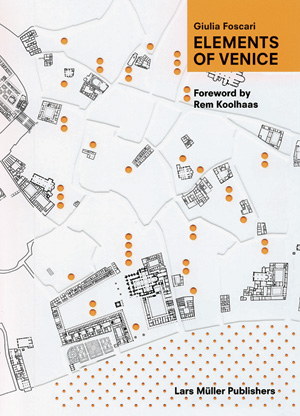To say Giulia Foscari's book is a beautifully put together trove of information about Venice's luxuriantly scenic architecture sounds gushy. Actually, it is an understatement. Foscari's distinctive analysis of the variegated riches that are a feast for the eye in this city of encrusted layers pays proper homage to its subject. By zeroing in on the architectonic vocabulary of facades, walls, ceilings, stairs, doors, and other elements, the author, who is a young architect in Hamburg, provides an intensive look into the creation of this water-bound urban place. The 6½-by-4¾-inch pages of this glossy paperback are artfully packed with texts, drawings, and photographs (though sometimes reading the tiny type is like taking an eye exam). Yet, because it can be easily held in your hands, you want to take it with you to visit the architecture under scrutiny, as inspirational perhaps as carrying an illuminated book of hours into a Gothic cathedral.
The impetus for Foscari's investigation stems from a research project she embarked on with Rem Koolhaas for his 2014 Venice Biennale exhibition and book, Elements of Architecture. While Koolhaas dissected the components of architecture, such as floors, walls, roofs, ceilings, and facades, in a general way, Foscari has applied the method to the particular city where she was born. She quotes from scholarly resources, and places the different parts and pieces of Venice's medieval, Renaissance, Baroque, and modern buildings against a tapestry of sociopolitical and economic history.
Hers is not a dry summation of facts but a compendium that also includes speculative observations. For example, the way the Doges Palace's double order of columns elevated the Grand Council chambers leads Foscari to say that this 14th-century design strategy could be “almost a prophetic precursor of Le Corbusier's principle . . . of raising the buildings above-ground by supporting them on pilotis.”
Foscari's analytic comparison of stairs by Jacopo Sansovino to those by Andrea Palladio stands out to those of us who, over time, may have lost some footing in such Venetian particulars. As she notes, Sansovino approached the stair as a promenade, connecting floors with dynamic diagonal flights at the Palazzo Gaddi in Rome (1530) and the Palazzo Grimani in Venice (1550s).
Palladio treated his stairs quite differently: the eight types he isolated in I Quattro Libri would not be called promenades. For Palladio, the stair was a “vertical conduit,” seen in the mesmerizing spiral of the Scala Ovata that he designed in 1561 inside the Convent of La Carita (later the Gallerie dell'Accademia). Going on to the modern, Foscari finds Carlo Scarpa's stair in the Casa Balboni (1974) a “somewhat ironic interpretation of the Palladian spiral staircase.”
There is much more to absorb here, including the evolution from cloth-covered panels to bottle-glass as window treatments and how that shift reflected changing notions of private and public space. Instead of textbook diagrams, the examples are beautifully illustrated with reproductions of paintings by Carpaccio and Tintoretto. The book is not the sort where you will find all the information (including many dates) about a landmark in one place. The organization of chapters, based on different typologies, means that we look at the facade of the Doges Palace first, and return to the building in a later chapter on ceilings. Nevertheless, this compelling history is stuffed with intriguing facts, quotations, and anecdotes from a long line of Venice's literary admirers. You embark on a procession without getting lost—unlike finding your way around la Serenissima itself.



Post a comment to this article
Report Abusive Comment